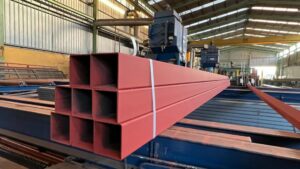Crude steel output in Ukraine collapsed by 37.9% in January-July 2022 to only 4.52 million tonnes as a result of Russia’s unprovoked invasion of the country that began in late February, according to a report published by national steelmakers’ union Ukrmetallurgprom on Tuesday August 9.
Pig iron production dropped by 38.1% to 4.82 million tonnes over the same period while rolled steel output totaled 4.23 million tonnes, down by 37.3% compared with the first seven months of 2021.
Earlier this year, the World Steel Association downgraded Ukraine to 21st place in the list of major steelmaking countries; it had ranked 14th in 2021.
The loss of control over assets in the once-besieged and now-flattened city of Mariupol, operated by Azovstal and Illych Steel and which belonged to major Ukrainian steelmaker Metinvest, was the main reason for the lower crude steel output.
The city has been occupied by Russian forces since late May, while the mills were seriously damaged by Russian artillery shelling and bombing.
In the first half of 2021, the two mills produced a total of 4.36 million tonnes of crude steel, according to Metinvest’s data.
Meanwhile, those few mills which continued to operate in Ukraine faced significant supply chain disruptions and logistical problems.
In particular, Metinvest wound down the iron ore mining operations at its Ingulets GOK, Southern GOK and Northern GOK units in July. The company continued production at Central GOK, but at a reduced level.
The company now has two assets left to supply – the flat steel-focused Zaporizhstal Iron & Steel Works in Zaporizhzhya, and the long steel-focused Kamet Steel mill in Kamianske, both in central Ukraine. Both were working at reduced capacity.
Meanwhile, ArcelorMittal Kryvyi Rih, the country’s second major steel producer, which specializes in long steel, planned to stop its mining and processing operations for three months starting in August, Ukrmetallurgprom said.
Port blockades and seizures by Russian forces were other big problems for Ukrainian steelmakers.
According to a map published by the UK ministry of defense on August 3, all the major ports on the Sea of Azov, as well as the port of Kherson, which has a river connection with the Black Sea, were currently controlled by Russia. Meanwhile, the major Black Sea ports were blocked for all vessels except those shipping grains and associated products and fertilizers, including ammonia.
This was hampering steel mills’ export opportunities because most Ukrainian steel was traditionally shipped to foreign consumers by sea.
Ukrainian steelmakers have had to look for alternative options for exporting their products. Among these was delivery of goods to Europe by truck and rail, as well as shipments from Black Sea ports in Romania and Bulgaria and from Baltic Sea ports in Poland.
According to Roman Perepelytsia, head of strategy and business development at Metinvest, there were two possible scenarios for the country’s steel industry in the coming years, depending on the outcome of the war against Russia.
Should Ukraine be victorious, its crude steel output could reach 7.6 million tonnes in 2022 and 8.3 million tonnes in 2023, while rolled steel output could reach 6.9 million tonnes in 2022 and 7.6 million tonnes in 2023, Perepelytsia told a meeting of the International Rebar Producers & Exporters Association (Irepas) in Istanbul at the end of May.
In the case of a prolonged war, which now looks more probable, the country’s steel output was expected to be only 6.5 million tonnes in 2022 and 6.1 million tonnes in 2023, while rolled steel output may amount to only 5.9 million tonnes in 2022 and 5.5 million tonnes in 2023.
Published by: Vlada Novokreshchenova






